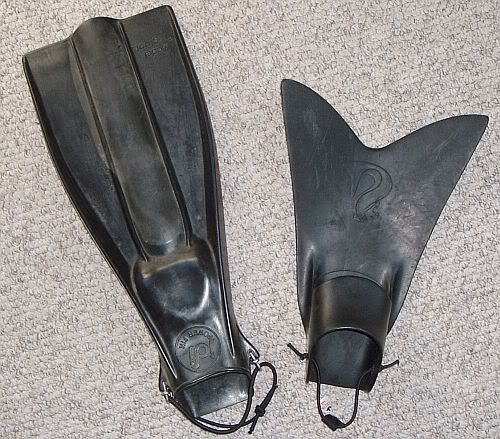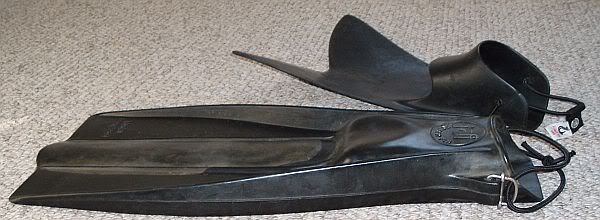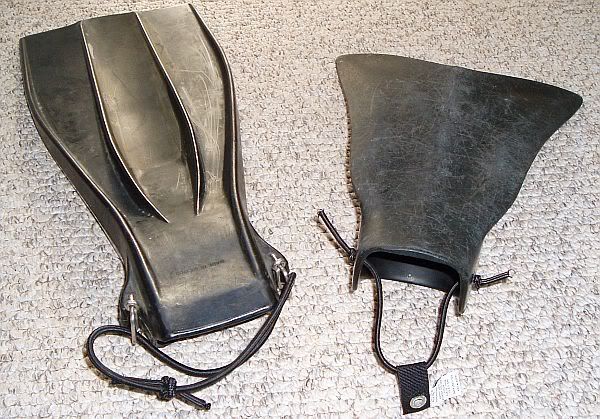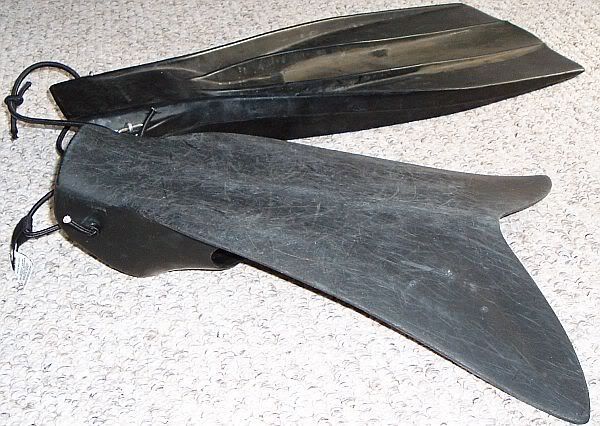Below are a few pics of a size large IDI Power Fin Frogfoot Model (now XS Scuba Frog Foot Fin) and an XL Force Fin Pro:
In addition to being longer, the frogfoot also has thick sides (like jets) and ridges which make the blade stiff and create channels to scoop and channel water when you kick. Of course each (fluttler) kick takes a lot more effort than with the short, flexible force fin blades, but since you presumably get more umpf from each kick with the larger, stiffer blade you should be able to kick less frequently, or kick and glide, so it may take less energy overall. I guess the right balance between size and stiffness may vary by person.
Because the FF's designed for flutter kicking I found this comment interesting from someone who was doing fin tests and sought experienced FF users to make sure the test was fair. His
comment:
I tracked down two such divers, but one was traveling in Alaska and unavailable at the time. Thus, I was only able to get one (identified as diver "z" in the speed data, an instructor with over 2,700 dives, mostly with FFs) to run the tests to date. He did excellent with the FFs (using the Tan Delta model). When moving at normal diving speeds, he used a kick style, sort of a modified frog kick with a twist at the end (which I've also observed among a couple of dive masters in the tropics) that appeared very efficient and required only about one kick to five or six of my normal flutter kicks. I was unable to duplicate that kick even after watching and trying it for much of one of our dives together.
When moving faster, for maximum speed, he switched to a regular flutter kick. He was able to get better speed from the FFs than from the other fins that he tried, better speeds than the other divers got with the FFs (original model), and right up there with the top speeds (but not the very top) that anyone got with any of the fins. I was able to get good speed myself with his ff-td, but not quite as fast as I could get with the ap-blu. I have to conclude that I'm missing something in Force Fins and still don't understand them. They might have a learning curve not found with most other fins. Force Fins may be very fast and efficient if used properly by some people. I'm hoping to also run further tests by other experienced users of Force Fins.
So it seems that with the more rigid FF models at least you can still do some sort of alternate kicks and glides. But for the frog kick you use the bottom of the fin blade, and the original, pro or tan delta of the original force fins just don't look like they be good for that (blade curled up, no channels):
The Tan Delta Excellerating Fin looks flatter and has a bit of a channel at the bottom, and the tan delta material is supposed to be stiff, so maybe that could be good for frog kicking but then again at $629 they are not a practical choice for most people (maybe that's what the tester above was using):
Anyway, my guess would be that jets and similar fins are so good because they are have flat blades with channels at the bottom so they are good for scooping and channeling water the way you do with frog and modified frog kicks, and the blade is relatively rigid because of the thick sides and ridges, but still flexible enough because of the rubber compound to have some amount of snap. Not sure if the weight is a bonus or not, I think it could go either way...











